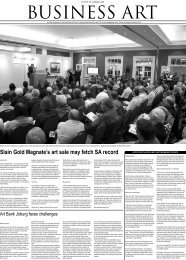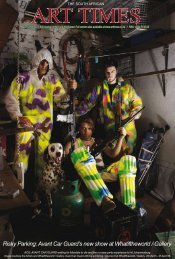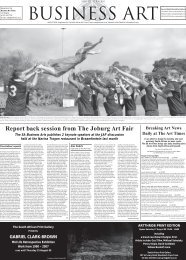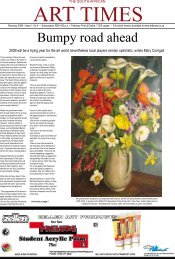Zavick & Ulric's washline fire burns brightly - South African Art Times
Zavick & Ulric's washline fire burns brightly - South African Art Times
Zavick & Ulric's washline fire burns brightly - South African Art Times
You also want an ePaper? Increase the reach of your titles
YUMPU automatically turns print PDFs into web optimized ePapers that Google loves.
Rip, Stitch, Mix and Burn: <strong>Zavick</strong> Zaroff Botha and Ulric Roldanus set <strong>fire</strong> to a washing line piece,<br />
entitled “Fresh Laundry”, Llandudno Beach, 21 November 2008<br />
Rip, Stitch, Mix and Burn -<br />
<strong>Zavick</strong> and Ulric Remix Sculpture<br />
y David Robert Lewis<br />
HEN early 20th Century<br />
ritic of psychoanalysis Karl Kraus<br />
roclaimed, in his attack against<br />
reud and the Austrian school:<br />
From now only piracy will be<br />
ermitted,” he was merely answerng<br />
the terrifying problematic which<br />
merican, Ralph Waldo Emerson<br />
ad previously delineated: “It<br />
s as difficult to appropriate the<br />
houghts of others, as it is to<br />
nvent,” consequently all forms of<br />
ppropriation, whether they be the<br />
utright theft of the remix pirate,<br />
he anti-hierarchic nomadism of<br />
he schizophrenic or the mashup<br />
ulture of the hip-hop musician,<br />
re all really just comments on the<br />
rtistic process we call invention.<br />
o be alive in the maelstrom<br />
f today’s insanely literary pop<br />
ulture, to write about art, is to<br />
isk offending highbrow critics<br />
ho maintain theory is the sole<br />
rerogative of the academic, that<br />
ny discourse is invariably that of<br />
he Western Canon vs the Other<br />
nd all activities, including the<br />
ctivity of art should, and can only<br />
e, understood from within the<br />
ealm of polite bourgeois society,<br />
hrough a lens provided by doestic<br />
homeland safety security<br />
egulations, 2010 soccer stadiums<br />
nd a city by-law prohibiting urinaion,<br />
belching, farting in public and<br />
oxious odours?<br />
ake <strong>Zavick</strong> Zwaroff Botha and<br />
lric Roldenaus’ recent collaboraive<br />
excursion into the public art<br />
rena. A series of washing lines<br />
hat have appeared across the<br />
ity, from Gugulethu to Thibault<br />
quare, The Kramat to Slave<br />
onument on Church, echoing<br />
he earlier interventions by Garth<br />
rasmus and Victor Peterson,<br />
ho erected a simple Washing<br />
ine over a decade ago, during<br />
he 1996 District Six sculpture<br />
estival: “The need to remember<br />
very detail of what has been lost<br />
aunts those who have lost it: the<br />
nstinct of the amputee to exercise<br />
he absent limb. The urgent desire<br />
o re-establish the security of what<br />
s known and familiar; of that which<br />
eminds you of yourself, and says<br />
o others that you exist.”(1)<br />
Fresh washing” by the non-existnt,<br />
the absent stage like Jan Van<br />
chalkwyk’s landscape entitled:<br />
For more info and review: http://davidrobertlewis.wordpress.com<br />
‘Kassiesbaai Washing Line’, a poor<br />
imitation of an earlier Constable,<br />
who no doubt would also have<br />
issues with who did the laundry<br />
when, and in what order. Servant,<br />
worker, waterman, thief. Looking at<br />
art through detergent is like examining<br />
the proverbial water closet.<br />
How much has changed, in power<br />
relations and the strength of OMO,<br />
since the first troglodyte dreamt<br />
up this most laborious of practices<br />
and then proceeded to paint and<br />
sculpt the end product - forgetting<br />
about our rights to a living wage,<br />
or the problem of not owning the<br />
means of production which in turn<br />
produced what we like to refer to<br />
as visual art?<br />
“In the Netherlands we don’t have<br />
laundry lines, says Ulric, over<br />
an Amstel at the Obscafe, here I<br />
encountered these lines again...”<br />
My carefully crafted notes are<br />
rendered into meaningless laundry<br />
list by a group art exhibition<br />
held later at Michael Stevenson,<br />
requiring the writer to decipher<br />
hieroglyphics, code by Sun Ra. “I<br />
have vandalised my work,” offers<br />
<strong>Zavick</strong> who expresses a penchant<br />
for quilting and embroidery.<br />
Incisions into the cultural landscape<br />
of Cape Town that beckon<br />
us all to take cognisance of the<br />
process of bricolage, elucidated<br />
by the grand semiotician Roland<br />
Barthes in the Empire of Signs<br />
- the artist as revolutionary DIY, an<br />
eternally recurring and everpresent<br />
‘nowever’amidst a clusterbomb of<br />
found objects or objets trouves.<br />
When all one has is a box of<br />
lion matches, and an Amstel, a<br />
bon<strong>fire</strong> will do. Rip, Stitch, Mix and<br />
Burn, with the type of arson that<br />
is required to turn theory of the<br />
haphazard, into chance, extraordinary<br />
aggregate of molecular<br />
love, incendiary performance<br />
art, nocturnal emissions of toxic<br />
fumes, the nightly annihilation of<br />
self practised by practitioners of<br />
Butoh and advocates of Zen.<br />
I encounter the quilty duvet<br />
inspired: “Washing line”, (there<br />
can only be one, all of the rest are<br />
replicas) strung between two poles<br />
on Llandudno beach. <strong>Zavick</strong>s laundry<br />
is caught up in moral exegesis<br />
on the joys of igniting the Atlantic<br />
sunset with gaseous plumes,<br />
offending a bunch of art directors<br />
who are trying to shoot a Thomas<br />
Cook travel commercial. I am a<br />
tourist trapped in a Swedish movie<br />
by Russian film director, Andre<br />
Tarkovsky, you know the one<br />
– Sacrifice – all time best picture &<br />
f-ck Ingmar Bergman.<br />
Supa’dog’s underpants are now<br />
being sacrificed with a long slow<br />
burn that is caught on multi-dimensional<br />
digital chips and filtered<br />
back to those of you who live<br />
in the future – Ozzy Osbourne<br />
burning a guitar like Jimi Hendrix<br />
in a remix scene from Francis<br />
Ford Coppolla’s Apocalypse Now<br />
-- the attack on bourgois art theory<br />
has begun, still we are living in<br />
a pastiche of cross-referential<br />
excess. What one desires, or<br />
needs is 50seconds of WaWaWa,<br />
how many WWWashinglines were<br />
set on <strong>fire</strong>? According to Wikipedia<br />
Washingline <strong>fire</strong>s have started to<br />
catch-on. The <strong>fire</strong> department is<br />
worried. The mayor is no longer<br />
taking calls, but wants a ban on<br />
laundromat bon<strong>fire</strong>s in place<br />
before 2010.<br />
With all this laundryline sampling<br />
art, what next? A soap commercial<br />
from Pears and Mary Quant?<br />
Could soap become the next<br />
bubble, as highbrow executive art<br />
galleries are doomed to reproduce<br />
in comic detail the artefacts of<br />
the day, (mortgage bonds, class<br />
traitors) what could be considered<br />
theatre in the round dished up to<br />
the well-healed, the sartorial few<br />
who live on sushi lunches and<br />
demand easily digested, and saleable<br />
pap for bread.<br />
The only solution lies in a total denial<br />
of any form of representation.<br />
In the same way it is impossible<br />
to identify the water that forms a<br />
river because a river can only exist<br />
by the grace of its movement. The<br />
sphinx has spoken. To the death of<br />
art and an ode to its destruction.<br />
(1) Emma Bedford and Tracy<br />
Murinik Re-membering that place-<br />
public projects in District 6. District<br />
6 Public Sculpture Exhibition 1996.<br />
[David Robert Lewis has written art<br />
reviews for the Cape <strong>Times</strong>. His<br />
involvement in visual arts includes,<br />
Gallery Mau Mau, Sub Liberation<br />
Underground, Invisible Graffiti,<br />
Human Etchings, amongst other<br />
things]<br />
Nicola Danby, director of <strong>Art</strong>insure – former head of BASA; Dr Fred<br />
Scott, well-known art collector and speaker at the event; with Gordon<br />
Massie, MD of <strong>Art</strong>insure who has brought his international expertise to<br />
<strong>South</strong> Africa and partnered with Hollard to deliver specialist insurance for<br />
investors in art.<br />
Bottem: (left to right) Lee-Ann Dobrescu, Operations Manager of Hollard<br />
Insurance Partners; Clive Kellner, head of the Johannesburg <strong>Art</strong> Gallery<br />
and Gordon Massie, MD of <strong>Art</strong>insure<br />
<strong>Art</strong> is big business and growing<br />
steadily despite financial world crashs<br />
There has been an unprecedented<br />
growth in the value of art globally<br />
and <strong>South</strong> Africa is keeping pace,<br />
said Nicola Danby, director of <strong>Art</strong>insure<br />
– formerly head of BASA.<br />
She was speaking at a recent<br />
event held by <strong>Art</strong>insure and Hollard<br />
in Johannesburg to discuss<br />
the ‘value of art in the <strong>South</strong><br />
<strong>African</strong> context’ with leaders in<br />
the field who gathered to hear art<br />
insurance expert, Gordon Massie<br />
and well-known collector Dr Fred<br />
Scott talk on the subject.<br />
“Latest annual figures of global<br />
art sales are $25 billion with a<br />
19% increase in value last year,<br />
particularly in contemporary pieces<br />
created from 1960 onwards,” MD<br />
of <strong>Art</strong>insure, Gordon Massie, said.<br />
He pointed out that the last time<br />
the financial world crashed in the<br />
80s the value of art crashed with it.<br />
“But this time the development has<br />
been different with the art world<br />
being bolstered by investors from<br />
Middle East Royal Families and<br />
BRIC countries: Brazil, Russia,<br />
India and China who have been<br />
buying high value works in spite of<br />
the shaky situation in the financial<br />
world.” An example of this, he<br />
said, was the fact that Damien<br />
Hirst opened his solo show the<br />
day after the Lehman Brothers<br />
crash and AIG rescue plan and<br />
netted himself a profit of $200<br />
million. “Whilst there is evidence<br />
of a correction taking place, <strong>Art</strong><br />
continues to sell as evidenced in<br />
recent sales. At a major sale I was<br />
at in early November an investor<br />
said to me ‘You would not believe<br />
there is a credit crunch going on<br />
out there!’”<br />
Massie says good news for local<br />
investors is that well known <strong>South</strong><br />
<strong>African</strong> artists are also becoming<br />
international brands and the local<br />
market is experiencing significant<br />
increases in values.<br />
As an example, he explained<br />
that if a <strong>South</strong> <strong>African</strong> investor in<br />
art had spent 100 Euros on an<br />
Irma Stern work in 1997, today it<br />
would be worth 1500 Euros. “As<br />
art develops into a truly attractive<br />
investment, owners need to be<br />
sure that their insurer appreciates<br />
the true value of their art works.<br />
There have been recent examples<br />
where claims were inexpertly handled.<br />
For instance in one specific<br />
example, a R12 million painting<br />
by a well known <strong>South</strong> <strong>African</strong><br />
artist was stolen and due to lack<br />
of expertise, the insurer offered to<br />
replace this premier painting with<br />
another painting by the same art<br />
ist. The trouble was the intended<br />
replacement painting only had<br />
a market value of R500 000.<br />
Underwriting and evaluating art<br />
is a specialist area and collectors<br />
need to be sure they are protected<br />
effectively against loss by people<br />
who understand the art world and<br />
true market values.”<br />
Massie also demonstrated by<br />
using true examples that <strong>fire</strong> is the<br />
biggest risk to artwork followed by<br />
accidental damage and then water<br />
damage. “Whilst theft is a risk the<br />
probability of a theft is lower than<br />
these three risks,” Massie said.<br />
Photo: Ryszard Kasiewicz<br />
<strong>Art</strong>istic Director of<br />
Documenta 13<br />
Announced<br />
The curator Carolyn Christov-<br />
Bakargiev, and author of the<br />
very first monograph on William<br />
Kentridge, has been selected as<br />
the artistic director of Documenta<br />
13, scheduled for June, 2012, in<br />
Kassel, Germany.<br />
The CEO of Documenta and the<br />
Fridericianum museum, Bernd<br />
Leifeld, announced that the<br />
supervisory board of Documenta<br />
unanimously agreed to her appointment,<br />
following a proposal<br />
by the international ‘finding’<br />
committee.<br />
Carolyn Christov-Bakargiev<br />
is one of a new generation of<br />
international curators and art<br />
commentators on the fast track.<br />
She is familiar with <strong>South</strong> <strong>African</strong><br />
art, mainly through her association<br />
with William Kentridge, whose<br />
local retrospective of 2004 she<br />
co-curated.<br />
She has just had a major<br />
international success as artistic<br />
director of the Sydney Biennale,<br />
but is based at the Castello di<br />
Rivoli museum of contemporary<br />
art in Turin as chief curator. From<br />
1999 to 2001 she was at the PS1<br />
contemporary art centre in New<br />
York.<br />
Christov-Bakargiev graduated<br />
magna cum laude from the University<br />
of Pisa, Faculty of letters<br />
and philosophy, in 1981. Her<br />
master thesis was on the relation<br />
between contemporary poetry and<br />
painting.<br />
Her appointment to the highly-visible,<br />
globally-influential post as<br />
director of Documenta 13, comes<br />
with high kudos. The ‘finding’<br />
committee reads like a who’s-who<br />
of the contemporary art world:<br />
Joseph Backstein (director,<br />
Institute of Contemporary <strong>Art</strong>,<br />
Moscow), Manuel J. Borja-Villel<br />
(director Museo Nacional Centro<br />
de <strong>Art</strong>e Reina Sofia, Madrid),<br />
Kathy Halbreich (associate director<br />
Museum of Modern <strong>Art</strong>, New<br />
York), Paulo Herkenhoff (formerly<br />
director of Museu Nacional Belas<br />
<strong>Art</strong>es, Rio de Janeiro), Oscar<br />
Ho (Chinese University of Hong<br />
Kong), Udo Kittelmann (director<br />
Museum für Moderne Kunst,<br />
Frankfurt), Kasper König (director<br />
Museum Ludwig, Köln), Elizabeth<br />
Ann Macgregor (director Museum<br />
of Contemporary <strong>Art</strong>, Sydney) and<br />
Rein Wolfs (artistic director of the<br />
Kunsthalle Fridericianum, Kassel).







